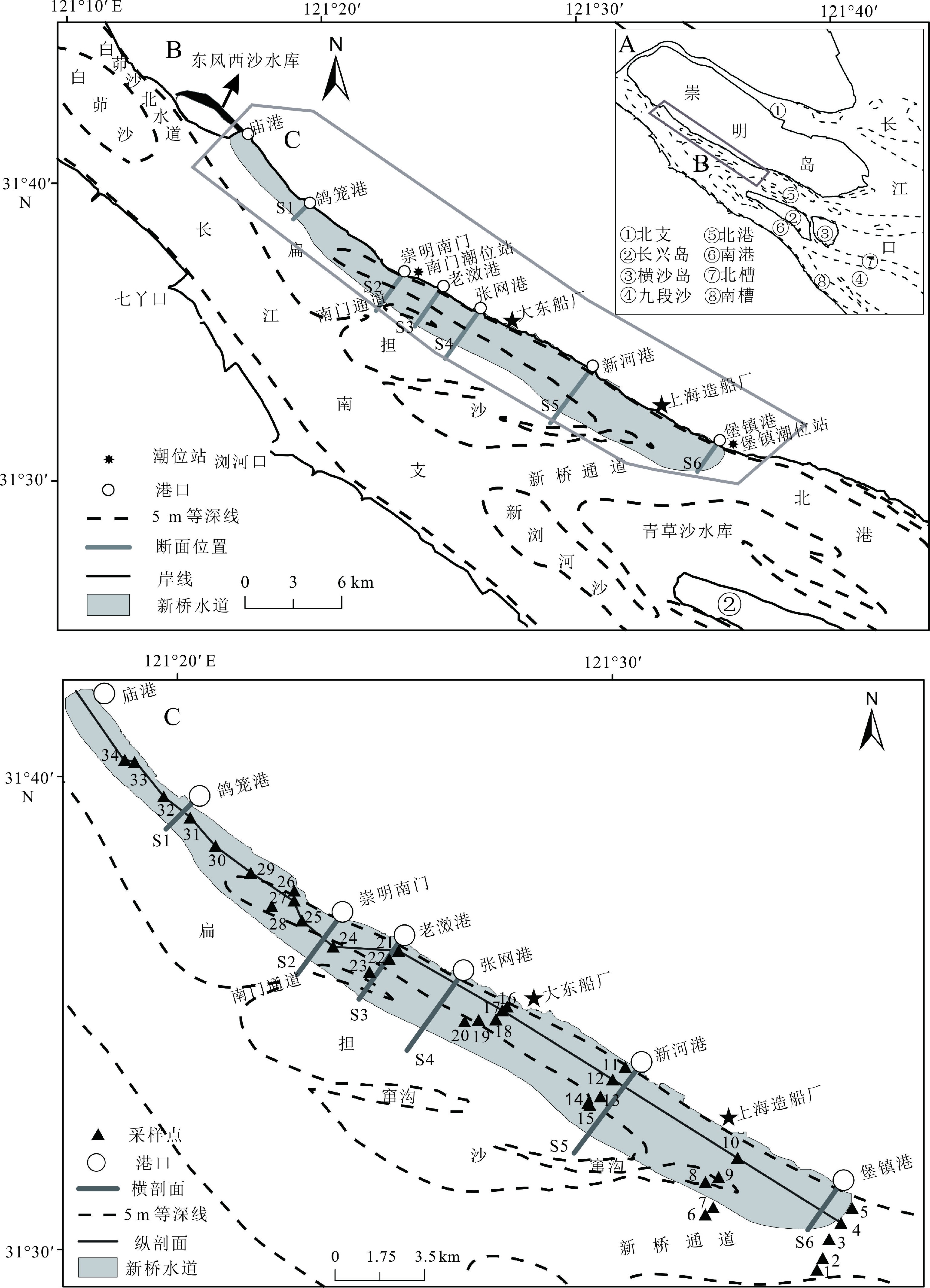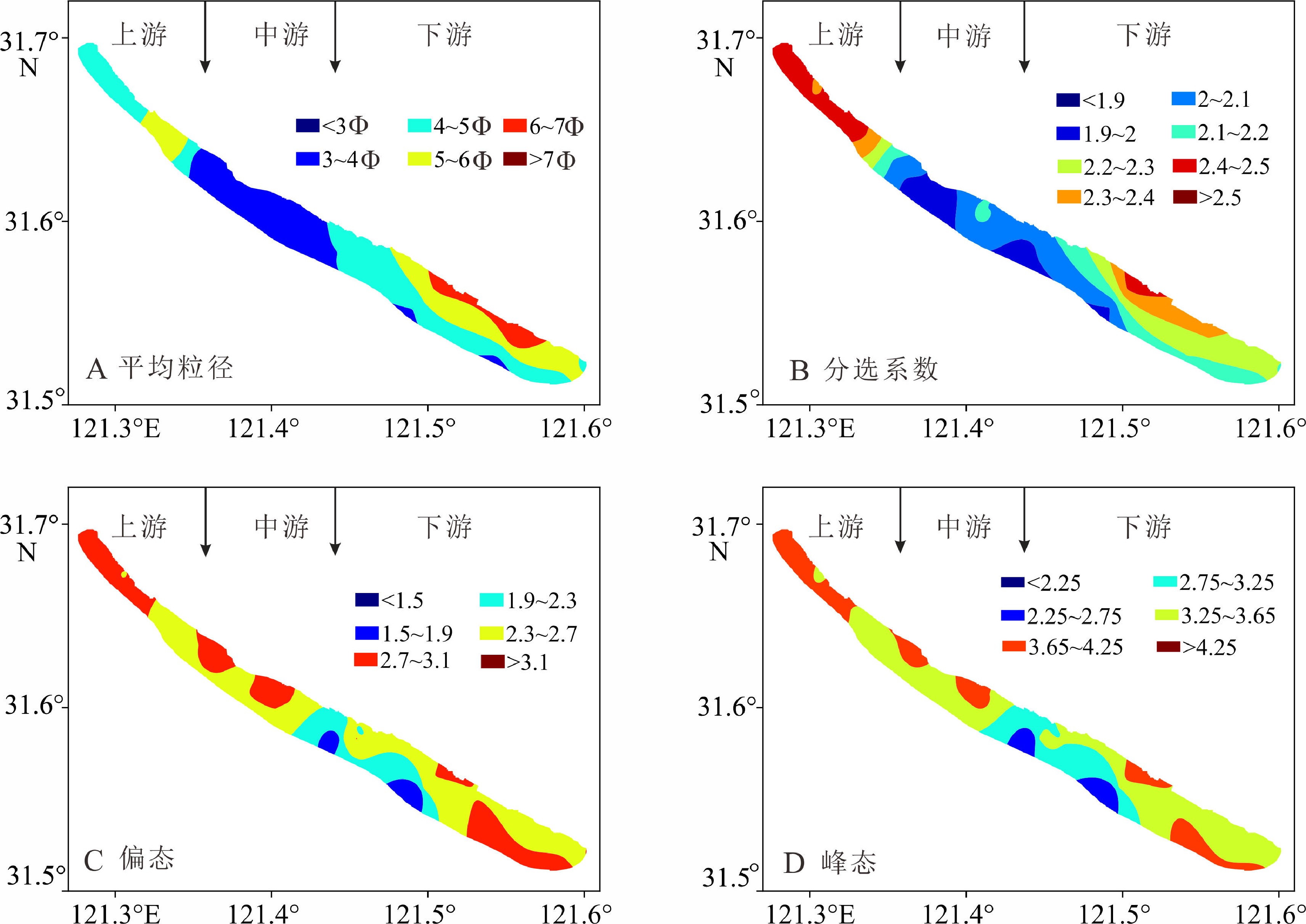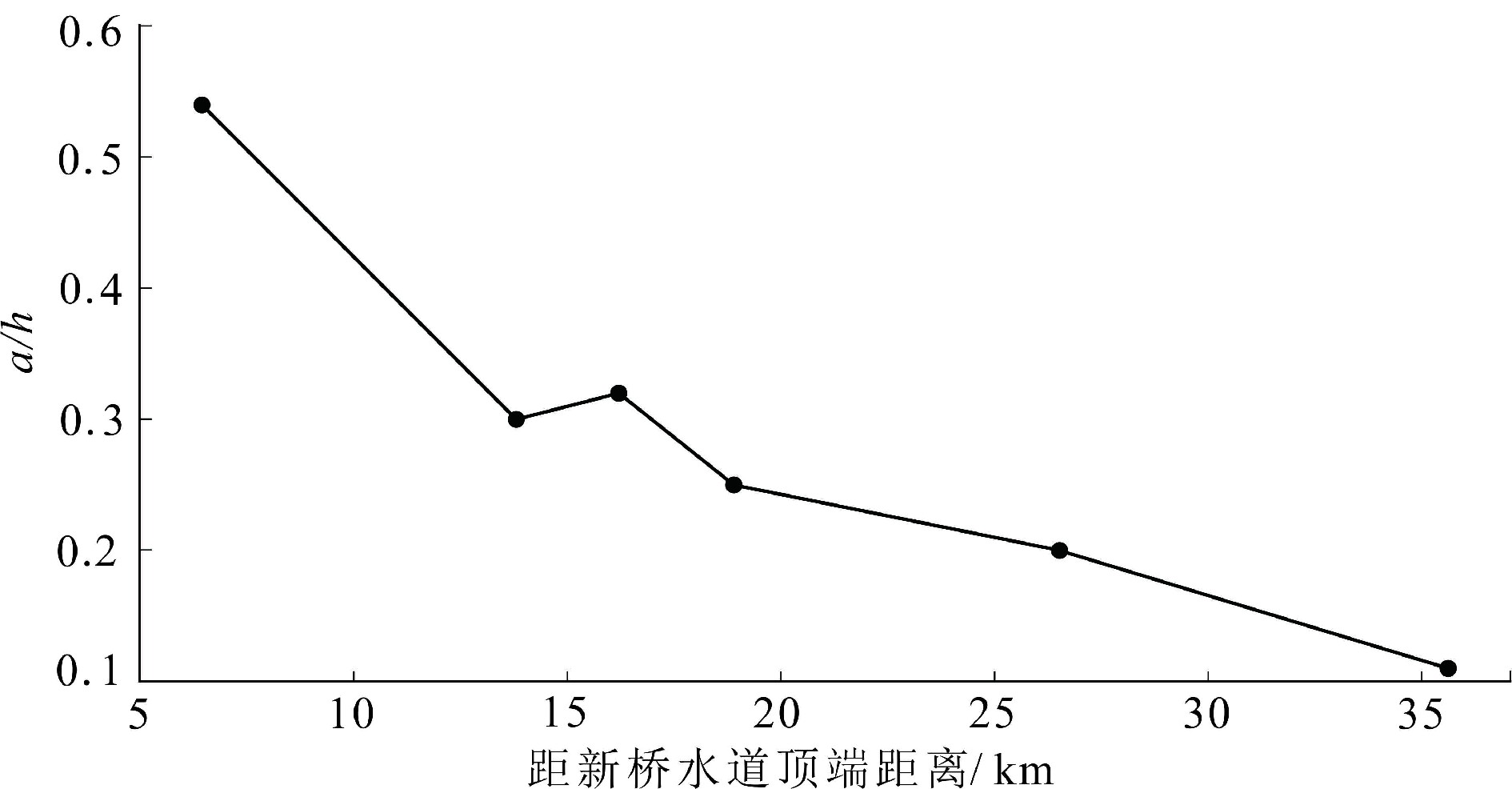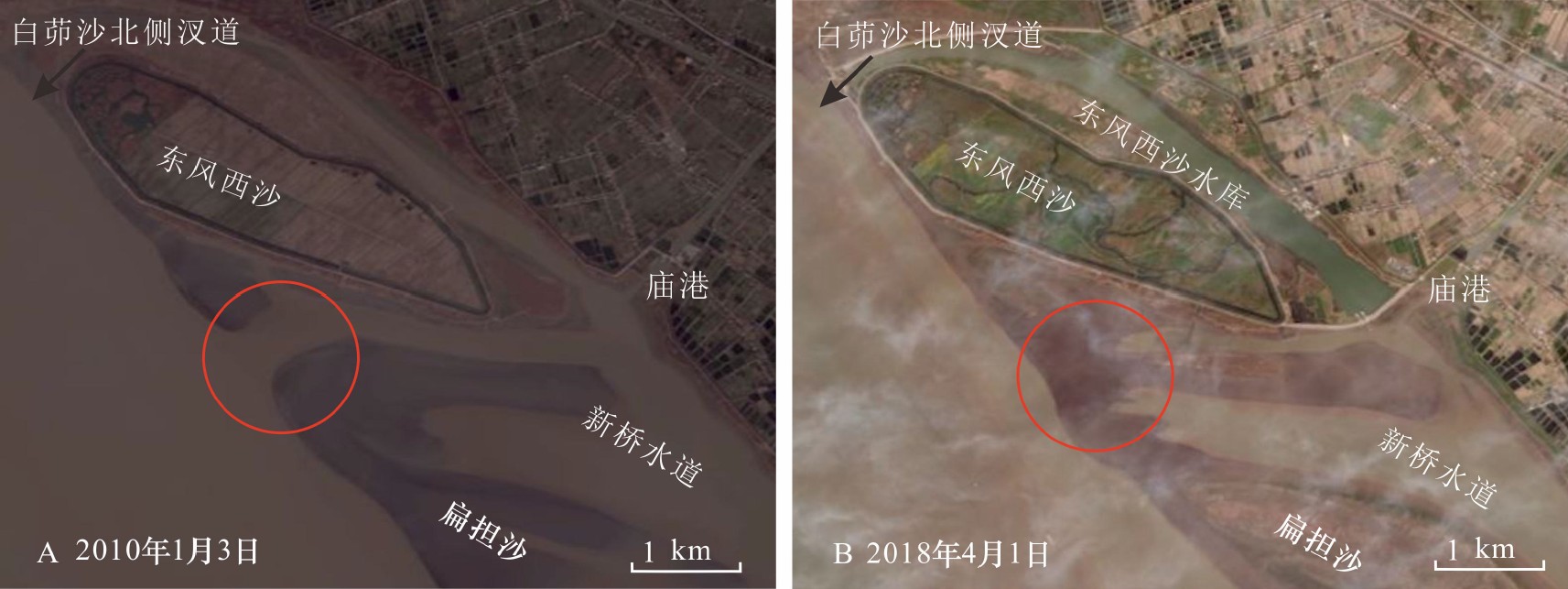Surface sediment distribution pattern of the Xinqiao Channel of Changjiang Estuary and its controlling factors
-
摘要: 涨潮槽是全球河口普遍存在的重要地貌单元,其动力沉积过程直接关乎河口涨潮槽冲淤稳定。但因径、潮流耦合及高强度人类活动,当前世界大部分河口涨潮槽动力沉积已发生迅速变化,进而引起河槽萎缩。基于此,以2020年6月在长江口南支最大的涨潮槽——新桥水道采集的大范围表层沉积物样品为基础,利用样品的粒径数据并借助经验正交函数(EOF)开展新桥水道表层沉积物分布格局及其影响因素研究。结果表明:新桥水道可分为3个沉积区,其中新桥水道上游河段沉积物主要由粉砂质砂和黏土质粉砂组成,沉积物分选较差;新桥水道中游河段沉积物由砂组成,沉积物分选较好;新桥水道下游河段沉积物分选性差,主要由砂、粉砂质砂、砂质粉砂以及黏土质粉砂组成。新桥水道沉积动力特征可以分为3种模式,其中主要模式为径流和潮流共同作用下,新桥水道上游及下游局部河道形成以砂质粉砂与黏土质粉砂为主的沉积格局;次要模式为局部河势影响下,新桥水道中、下游局部河段形成以粉砂质砂为主的沉积格局;第三模式为洪季径流影响下以砂为主的沉积格局。扁担沙沙尾下移导致进入新桥水道径流增强引起表层沉积物变粗。东风西沙水库的构建诱发新桥水道上段尖端沉积物变细。Abstract: Flood-dominated channel is an important geomorphic unit in estuaries. Its dynamic sedimentation process is directly related to the dynamics of erosion-deposition system of the channel. However, due to the runoff-tide interaction and intensive human activities, the dynamics of sedimentation process for most of estuarine flood channels in the world is rapidly changing, led to channel shrinkage. Based on the grain-size parameters of the surface sediments collected along the Xinqiao Channel, the largest flooding channel in the South Branch of Changjiang Estuary, the distribution pattern of the surface sediments in the Xinqiao Channel and its influencing factors are carefully studied in this paper with the method of empirical orthogonal function (EOF). The Xinqiao Channel can be divided into three depositional zones. The upstream of the channel is mainly composed of silty sand and clayey silty sand which are poor in sorting and the middle of the channel is characterized by well sorted sands, while in the downstream of the channel, the sediments are mainly composed of sand, silty sand, sandy silt and clayey silty sand, which are poorly sorted. From the viewpoint of sedimentary dynamics, the surface sediments in the Xinqiao Channel can be classified into three modes. The major mode is dominated by sandy silt and clayey silt prevailed in the upstream and part of the downstream, deposited under the control of the joint action of runoff and tide. The secondary mode is dominated by silty sand in the middle and part of the downstream, under the control of local fluvial regime. The third mode, characterized by sandy deposits, is formed by runoff in flooding seasons. In addition, the downward movement of the tail of Biandan Shoal has enhanced the runoff entering the Xinqiao Channel, that results in the coarsening of surface sediment. The construction of the Dongfengxisha Reservoir caused to the fining up of surface sediment at the tip of upper Xinqiao Channel.
-
Keywords:
- grain size characteristics /
- flood channel /
- sedimentation models /
- EOF anlysis /
- Changjiang Estuary
-
-
表 1 EOF分析的前3个模态贡献率及其累计贡献率
Table 1 The cumulative contributions of the first three modes by EOF analysis
标准化矩阵 贡献率/ % 累计贡献率/ % 第一模态 59% 59% 第二模态 11% 70% 第三模态 10% 80% -
[1] Barua D K. Suspended sediment movement in the estuary of the Ganges-Brahmaputra-Meghna river system [J]. Marine Geology, 1990, 91(3): 243-253. doi: 10.1016/0025-3227(90)90039-M
[2] Mitchell S B, Uncles R J. Estuarine sediments in macrotidal estuaries: future research requirements and management challenges [J]. Ocean & Coastal Management, 2013, 79: 97-100.
[3] Green M O, Bell R G, Dolphin T J, et al. Silt and sand transport in a deep tidal channel of a large estuary (Manukau Harbour, New Zealand) [J]. Marine Geology, 2000, 163(1-4): 217-240. doi: 10.1016/S0025-3227(99)00102-4
[4] Gong W P, Jia L W, Shen J, et al. Sediment transport in response to changes in river discharge and tidal mixing in a funnel-shaped micro-tidal estuary [J]. Continental Shelf Research, 2014, 76: 89-107. doi: 10.1016/j.csr.2014.01.006
[5] 张云峰, 张振克, 刘玉卿, 等. 长江口北支沉积动力变化及对人类活动的响应[J]. 人民长江, 2019, 50(9):24-29 ZHANG Yunfeng, ZHANG Zhenke, LIU Yuqing, et al. Sediment dynamic processes in North Branch of Yangtze River Estuary and response to human activities [J]. Yangtze River, 2019, 50(9): 24-29.
[6] 时翠, 甘华阳, 夏真, 等. 珠江口内伶仃洋表层沉积物粒度特征及其运移趋势[J]. 海洋地质与第四纪地质, 2015, 35(1):13-20 SHI Cui, GAN Huayang, XIA Zhen, et al. Characteristics and transport trend of surface sediments in inner Lingdingyang firth of the Pearl River Estuary [J]. Marine Geology & Quaternary Geology, 2015, 35(1): 13-20.
[7] Cheng Z X, Wang X H, Jalón-Rojas I, et al. Reconstruction of sedimentation changes under anthropogenic influence in a medium-scale estuary based on a decadal chronological framework [J]. Estuarine, Coastal and Shelf Science, 2019, 227: 106295. doi: 10.1016/j.ecss.2019.106295
[8] Kim T I, Choi B H, Lee S W. Hydrodynamics and sedimentation induced by large-scale coastal developments in the Keum River Estuary, Korea [J]. Estuarine, Coastal and Shelf Science, 2006, 68(3-4): 515-528. doi: 10.1016/j.ecss.2006.03.003
[9] Dai Z J, Fagherazzi S, Mei X F, et al. Linking the infilling of the North Branch in the Changjiang (Yangtze) Estuary to anthropogenic activities from 1958 to 2013 [J]. Marine Geology, 2016, 379: 1-12. doi: 10.1016/j.margeo.2016.05.006
[10] Lesourd S, Lesueur P, Fisson C, et al. Sediment evolution in the mouth of the Seine Estuary (France): a long-term monitoring during the last 150 years [J]. Comptes Rendus Geoscience, 2016, 348(6): 442-450. doi: 10.1016/j.crte.2015.08.001
[11] 王永红, 沈焕庭, 李九发, 等. 长江河口涨落潮槽沉积物特征及其动力响应[J]. 沉积学报, 2009, 27(3):511-517 WANG Yonghong, SHEN Huanting, LI Jiufa, et al. Sedimentary features of sediment and their responses to dynamics in the flood and ebb channel of the Changjiang Estuary [J]. Acta Sedimentologica Sinica, 2009, 27(3): 511-517.
[12] 闵凤阳, 汪亚平, 高建华, 等. 长江口北支的沉积物输运趋势[J]. 海洋通报, 2010, 29(3):264-270 doi: 10.3969/j.issn.1001-6392.2010.03.005 MIN Fengyang, WANG Yaping, GAO Jianhua, et al. Sediment transport pathway within the North Branch, Changjiang Estuary [J]. Marine Science Bulletin, 2010, 29(3): 264-270. doi: 10.3969/j.issn.1001-6392.2010.03.005
[13] 刘高峰, 沈焕庭, 王永红, 等. 长江口涨、落潮槽底沙输移趋势探讨[J]. 海洋通报, 2003, 22(4):1-7 doi: 10.3969/j.issn.1001-6392.2003.04.001 LIU Gaofeng, SHEN Huanting, WANG Yonghong, et al. Bottom sediment transport in the flood and ebb channels of the Changjiang Estuary [J]. Marine Science Bulletin, 2003, 22(4): 1-7. doi: 10.3969/j.issn.1001-6392.2003.04.001
[14] Zhang W, Zheng J H, Ji X M, et al. Surficial sediment distribution and the associated net sediment transport pattern retain->in the Pearl River Estuary, South China [J]. Continental Shelf Research, 2013, 61-62: 41-51. doi: 10.1016/j.csr.2013.04.011
[15] 刘高峰, 朱建荣, 沈焕庭, 等. 河口涨落潮槽水沙输运机制研究[J]. 泥沙研究, 2005(5):51-57 doi: 10.3321/j.issn:0468-155X.2005.05.009 LIU Gaofeng, ZHU Jianrong, SHEN Huanting, et al. Study on mechanism of water and suspended sediment transport in flood and ebb channels [J]. Journal of Sediment Research, 2005(5): 51-57. doi: 10.3321/j.issn:0468-155X.2005.05.009
[16] 李九发, 沈焕庭, 万新宁, 等. 长江河口涨潮槽泥沙运动规律[J]. 泥沙研究, 2004(5):34-40 doi: 10.3321/j.issn:0468-155X.2004.05.006 LI Jiufa, SHEN Huanting, WAN Xinning, et al. Sediment transport in flood channels of the Changjiang Estuary [J]. Journal of Sediment Research, 2004(5): 34-40. doi: 10.3321/j.issn:0468-155X.2004.05.006
[17] 刘苍字, 贾海林, 陈祥锋. 闽江河口沉积结构与沉积作用[J]. 海洋与湖沼, 2001, 32(2):177-184 doi: 10.3321/j.issn:0029-814X.2001.02.009 LIU Cangzi, JIA Hailin, CHEN Xiangfeng. Sedimentary texture and sedimentation in the Minjiang River Estuary [J]. Oceanologia et Limnologia Sinica, 2001, 32(2): 177-184. doi: 10.3321/j.issn:0029-814X.2001.02.009
[18] 冉隆江. 鸭绿江河口沉积物粒度分布特征及其对流域变化的响应[D]. 南京: 南京大学, 2012 RAN Longjiang. The gran size distribution characteristics of Yalu Estuary and its response to the change of the catchment[D]. Nanjing: Nanjing University, 2012.
[19] Cheng Z X, Jalon-Rójas I, Wang X H, et al. Impacts of land reclamation on sediment transport and sedimentary environment in a macro-tidal estuary [J]. Estuarine, Coastal and Shelf Science, 2020, 242: 106861. doi: 10.1016/j.ecss.2020.106861
[20] 游博文, 张国安, 李一鸣, 等. 近30年来长江口北支及口外沉积特征及输移趋势[J]. 长江流域资源与环境, 2018, 27(10):2328-2338 YOU Bowen, ZHANG Guoan, LI Yiming, et al. Sediment characteristics and transport trend in north branch and offshore area of Yangtze Estuary in the last 30 years [J]. Resources and Environment in the Yangtze Basin, 2018, 27(10): 2328-2338.
[21] Lou Y Y, Dai Z J, He Y Y, et al. Morphodynamic couplings between the Biandan Shoal and Xinqiao Channel, Changjiang (Yangtze) Estuary [J]. Ocean & Coastal Management, 2020, 183: 105036.
[22] Dai Z J, Mei X F, Darby S E, et al. Fluvial sediment transfer in the Changjiang (Yangtze) river-estuary depositional system [J]. Journal of Hydrology, 2018, 566: 719-734. doi: 10.1016/j.jhydrol.2018.09.019
[23] Lane E W. Report of the subcommittee on sediment terminology [J]. Eos, Transactions American Geophysical Union, 1947, 28(6): 936-938. doi: 10.1029/TR028i006p00936
[24] 马菲, 汪亚平, 李炎, 等. 地统计法支持的北部湾东部海域沉积物粒径趋势分析[J]. 地理学报, 2008, 63(11):1207-1217 doi: 10.3321/j.issn:0375-5444.2008.11.010 MA Fei, WANG Yaping, LI Yan, et al. The application of geostatistics to analysis of grain size trend in the Eastern Beibu Gulf [J]. Acta Geographica Sinica, 2008, 63(11): 1207-1217. doi: 10.3321/j.issn:0375-5444.2008.11.010
[25] McManus J. Grain size determination and interpretation[M]//Tucker M E. Techniques in Sedimentology. Oxford: Blackwell Scientific Publications, 1988: 63-85.
[26] Shepard F P. Nomenclature based on sand-silt-clay ratios [J]. Journal of sedimentary Research (SEPM), 1954, 24(3): 151-158.
[27] Lorenz E N. Empirical orthogonal functions and statistical weather prediction[R]. Bedford, MA: Massachusetts Institute of Technology, 1956: 49-50.
[28] 夏非, 张永战, 吴蔚. EOF分析在海岸地貌与沉积学研究中的应用进展[J]. 地理科学进展, 2009, 28(2):174-186 doi: 10.11820/dlkxjz.2009.02.003 XIA Fei, ZHANG Yongzhan, WU Wei. Progress in applications of the EOF analysis in the research of coastal geomorphology and sedimentology [J]. Progress in Geography, 2009, 28(2): 174-186. doi: 10.11820/dlkxjz.2009.02.003
[29] 林益帆, 戴志军, 谢华亮, 等. 长江河口近底层悬沙和沉积物的交换过程研究[J]. 海洋学报, 2014, 36(7):99-110 LIN Yifan, DAI Zhijun, XIE Hualiang, et al. The research of exchange processes between the suspended sediment near the bottom and the depositions in the Changjiang (Yangtze) Estuary [J]. Acta Oceanologica Sinica, 2014, 36(7): 99-110.
[30] 王永红. 长江河口涨潮槽的形成机理与动力沉积特征[D]. 上海: 华东师范大学, 2003 WANG Yonghong. Reformation mechanism and features of dynamic sediment in flood channels of the Changjiang Estuary[D]. Shanghai: East China Normal University, 2003.
[31] 沈焕庭, 潘定安. 长江河口潮流特性及其对河槽演变的影响[J]. 华东师范大学学报:自然科学版, 1979(1):131-144 SHEN Huanting, PAN Dingan. The tidal wave propagation and its effect on the channel evolution in the Changjiang Estuary [J]. Journal of East China Normal University:Natural Science, 1979(1): 131-144.
[32] Dronkers J. Tidal asymmetry and estuarine morphology [J]. Netherlands Journal of Sea Research, 1986, 20(2-3): 117-131. doi: 10.1016/0077-7579(86)90036-0
[33] Zhou Z, Coco G, Townend I, et al. On the stability relationships between tidal asymmetry and morphologies of tidal basins and estuaries [J]. Earth Surface Processes and Landforms, 2018, 43(9): 1943-1959. doi: 10.1002/esp.4366
[34] Matte P, Jay D A, Zaron E D. Adaptation of classical tidal harmonic analysis to nonstationary tides, with application to river tides [J]. Journal of Atmospheric and Oceanic Technology, 2013, 30(3): 569-589. doi: 10.1175/JTECH-D-12-00016.1
[35] 谢华亮, 戴志军, 吴莹, 等. 海南岛南渡江河口动力沉积模式[J]. 沉积学报, 2014, 32(5):884-892 XIE Hualiang, DAI Zhijun, WU Ying, et al. Sedimentation dynamic modes of the Nandujiang Estuary, Hainan island [J]. Acta Sedimentologica Sinica, 2014, 32(5): 884-892.
[36] 陈沈良, 严肃庄, 李玉中. 长江口及其邻近海域表层沉积物分布特征[J]. 长江流域资源与环境, 2009, 18(2):152-156 doi: 10.3969/j.issn.1004-8227.2009.02.010 CHEN Shenliang, YAN Suzhuang, LI Yuzhong. Characteristics of surface sediment distribution in the Yangtze Estuary and its adjacent waters [J]. Resources and Environment in the Yangtze Basin, 2009, 18(2): 152-156. doi: 10.3969/j.issn.1004-8227.2009.02.010
[37] 赵建春, 戴志军, 李九发, 等. 强潮海湾近岸表层沉积物时空分布特征及水动力响应: 以杭州湾北岸为例[J]. 沉积学报, 2008, 26(6):1043-1051 ZHAO Jianchun, DAI Zhijun, LI Jiufa, et al. Study on the characteristics of temporal and spatial changes in properties of surface sediment on near-shore seabed of strong-tide bay: a case from the north bank of Hangzhou Bay in Shanghai [J]. Acta Sedimentologica Sinica, 2008, 26(6): 1043-1051.
[38] 黎树式, 戴志军, 葛振鹏, 等. 强潮海滩响应威马逊台风作用动力沉积过程研究: 以北海银滩为例[J]. 海洋工程, 2017, 35(3):89-98 LI Shushi, DAI Zhijun, GE Zhepeng, et al. Sediment dynamic processes of macro tidal beach in response to Typhoon Rammasun action: a case study of Yintan, Beihai [J]. The Ocean Engineering, 2017, 35(3): 89-98.
[39] 沈焕庭, 李九发, 金元欢. 河口涨潮槽的演变及治理[J]. 海洋与湖沼, 1995, 26(1):83-89 doi: 10.3321/j.issn:0029-814X.1995.01.014 SHEN Huanting, LI Jiufa, JIN Yuanhuan. Evolution and regulation of flood channels in estuaries [J]. Oceanologia et Limnologia Sinica, 1995, 26(1): 83-89. doi: 10.3321/j.issn:0029-814X.1995.01.014
[40] Zhang K D, Li A C, Huang P, et al. Sedimentary responses to the cross-shelf transport of terrigenous material on the East China Sea continental shelf [J]. Sedimentary geology, 2019, 384: 50-59. doi: 10.1016/j.sedgeo.2019.03.006
[41] Li J C, Yao Q, Wang Y, et al. Grain-size characteristics of surface sediments of nebkhas at the southern margin of the Mu Us dune field, China [J]. Catena, 2019, 183: 104210. doi: 10.1016/j.catena.2019.104210
[42] Khiari N, Atoui A, Khalil N, et al. Dynamics of sediments along with their core properties in the Monastir-Bekalta coastline (Tunisia, Central Mediterranean) [J]. Journal of African Earth Sciences, 2017, 134: 320-331. doi: 10.1016/j.jafrearsci.2017.06.028
[43] Chu A, Wang Z B, De Vriend H J. Analysis on residual coarse sediment transport in estuaries [J]. Estuarine, Coastal and Shelf Science, 2015, 163: 194-205. doi: 10.1016/j.ecss.2015.06.003
[44] Brown J M, Davies A G. Flood/ebb tidal asymmetry in a shallow sandy estuary and the impact on net sand transport [J]. Geomorphology, 2010, 114(3): 431-439. doi: 10.1016/j.geomorph.2009.08.006
[45] Mei X F, Dai Z J, Wei W, et al. Secular bathymetric variations of the North Channel in the Changjiang (Yangtze) Estuary, China, 1880–2013: causes and effects [J]. Geomorphology, 2018, 303: 30-40. doi: 10.1016/j.geomorph.2017.11.014
[46] 姚弘毅. 近期长江口典型河道悬沙输运及其与底沙交换过程[D]. 上海: 华东师范大学, 2018 YAO Hongyi. Recent exchange between suspended sediment and bedload and sediment transport in typical branches of Yangtze Estuary[D]. Shanghai: East China Normal University, 2018.
[47] 高敏, 李九发, 李占海, 等. 近期长江口南支河道洪季含沙量时间变化及床沙再悬浮研究[J]. 长江流域资源与环境, 2015, 24(1):30-38 doi: 10.11870/cjlyzyyhj201501005 GAO Min, LI Jiufa, LI Zhanhai, et al. Characteristics of temporal change of suspended sediment and bed load resuspension during flood season in the south branch of Changjiang Estuary [J]. Resources and Environment in the Yangtze Basin, 2015, 24(1): 30-38. doi: 10.11870/cjlyzyyhj201501005
[48] 何钰滢, 戴志军, 楼亚颖, 等. 长江口扁担沙动力地貌变化过程研究[J]. 海洋学报, 2020, 42(5):104-116 HE Yuying, DAI Zhijun, LOU Yaying, et al. Morphodynamic evolution of the Biandan Shoal in the Changjiang River Estuary [J]. Haiyang Xuebao, 2020, 42(5): 104-116.
[49] Mariotti G, Fagherazzi S. Channels-tidal flat sediment exchange: the channel spillover mechanism[J]. Journal of Geophysical Research: Oceans, 2012, 117(C3),doi: 10.1029/2011JC007378.
[50] Luo X X, Yang S L, Zhang J. The impact of the Three Gorges Dam on the downstream distribution and texture of sediments along the middle and lower Yangtze River (Changjiang) and its estuary, and subsequent sediment dispersal in the East China Sea [J]. Geomorphology, 2012, 179: 126-140. doi: 10.1016/j.geomorph.2012.05.034
[51] Luan H L, Ding P X, Wang Z B, et al. Decadal morphological evolution of the Yangtze Estuary in response to river input changes and estuarine engineering projects [J]. Geomorphology, 2016, 265: 12-23. doi: 10.1016/j.geomorph.2016.04.022
[52] 关许为, 刘晓敏. 东风西沙水库工程施工期主要风险因素及对策探析[J]. 水利科技, 2012(4):30-33 GUAN Xuwei, LIU Xiaomin. Analysis of main risk factors and countermeasures during construction of Dongfengxisha Reservoir [J]. Hydraulic Science and Technology, 2012(4): 30-33.




 下载:
下载:








